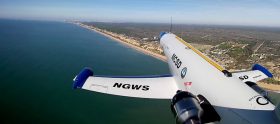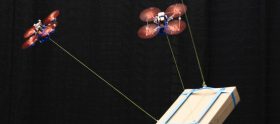Autonomous swarm intelligence
The use of unmanned aerial vehicles is increasingly gaining importance in industrial applications. However, especially where heavy loads, adverse weather conditions, and remote locations converge, conventional systems quickly reach their limits. Until now. Researchers at TU Delft have developed an algorithm that enables multiple autonomously operating transport drones to work together in a coordinated manner, even under challenging environmental conditions.


Limited range and restricted payload capacity are two central challenges when deploying UAS (Unmanned Aerial Systems) in a meaningful and economically sustainable way in commercial operating scenarios. „A single drone can only carry a very limited load“, explains Dr. Sihao Sun from the Faculty of Mechanical Engineering at TU Delft. „Delivering construction materials to remote areas, transporting large harvests, or deploying in rescue missions is therefore often not realistically feasible.”
Integrated system
To increase load capacity and range, a team led by Dr. Sihao Sun is pursuing the use of multiple multicopters that are connected by flexible cables to a shared payload. The scientific advance does not lie in enabling several drones to lift a larger load than one alone could. The truly innovative aspect is a specially developed algorithm that enables the drone swarm’s individual components to interact in a way that balances out vibrations and external influences from wind gusts. Once multiple drones are mechanically connected, each movement influences all others – and external factors such as wind or the pendulum-like swinging of a payload complicate the task further.
Traditional control algorithms do not react quickly enough in this situation. In contrast, the new approach is highly dynamic, adapting in real time to changing conditions and operating without additional sensors on the payload. What is intended to work over expansive agricultural fields or in offshore wind farms can already tackle quite demanding challenges under laboratory conditions. Up to four specially developed drones were able to transport a basket while overcoming tight obstacles. Simulated gusts of wind or a moving load – such as a basketball rolling around loosely in a basket – did not destabilize the system, and the composite managed all scenarios.
Currently, the testing environment is based on motion capture systems and is therefore limited to (virtual) indoor settings. However, the technology is intended to transition into real applications in the future, such as offshore infrastructure maintenance, search-and-rescue operations, or modern precision agriculture.







